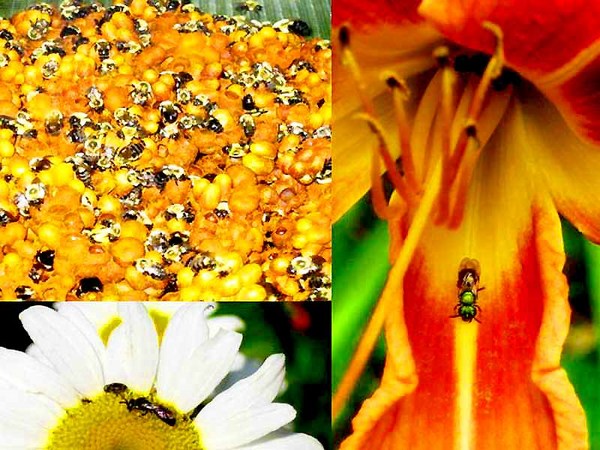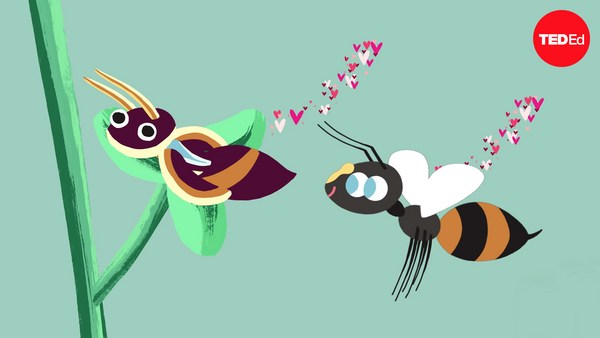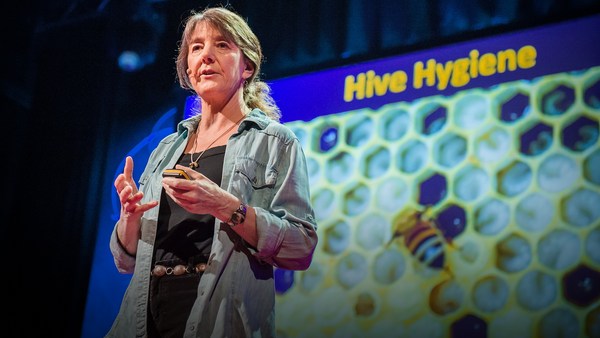Thank you. I have two missions here today. The first is to tell you something about pollen, I hope, and to convince you that it's more than just something that gets up your nose. And, secondly, to convince you that every home really ought to have a scanning electron microscope. (Laughter) Pollen is a flower's way of making more flowers. It carries male sex cells from one flower to another. This gives us genetic diversity, or at least it gives the plants genetic diversity. And it's really rather better not to mate with yourself. That's probably true of humans as well, mostly.
Pollen is produced by the anthers of flowers. Each anther can carry up to 100,000 grains of pollen, so, it's quite prolific stuff. And it isn't just bright flowers that have pollen; it's also trees and grasses. And remember that all our cereal crops are grasses as well.
Here is a scanning electron micrograph of a grain of pollen. The little hole in the middle, we'll come to a bit later, but that's for the pollen tube to come out later on. A very tiny tube. So, that's 20 micrometers across, that pollen grain there. That's about a 50th of a millimeter. But not all pollen is quite so simple looking.
This is Morina. This is a plant -- which I've always thought to be rather tedious -- named after Morin, who was an enterprising French gardener, who issued the first seed catalog in 1621. But anyway, take a look at its pollen. This is amazing, I think. That little hole in the middle there is for the pollen tube, and when the pollen finds its special female spot in another Morina flower, just on the right species, what happens? Like I said, pollen carries the male sex cells. If you actually didn't realize that plants have sex, they have rampant, promiscuous and really quite interesting and curious sex. Really. (Laughter) A lot.
My story is actually not about plant propagation, but about pollen itself. "So, what are pollen's properties?" I hear you ask. First of all, pollen is tiny. Yes we know that. It's also very biologically active, as anyone with hay fever will understand. Now, pollen from plants, which are wind-dispersed -- like trees and grasses and so on -- tend to cause the most hay fever. And the reason for that is they've got to chuck out masses and masses of pollen to have any chance of the pollen reaching another plant of the same species.
Here are some examples -- they're very smooth if you look at them -- of tree pollen that is meant to be carried by the wind. Again -- this time, sycamore -- wind-dispersed. So, trees: very boring flowers, not really trying to attract insects. Cool pollen, though. This one I particularly like. This is the Monterey Pine, which has little air sacks to make the pollen carry even further. Remember, that thing is just about 30 micrometers across.
Now, it's much more efficient if you can get insects to do your bidding. This is a bee's leg with the pollen glommed onto it from a mallow plant. And this is the outrageous and beautiful flower of the mangrove palm. Very showy, to attract lots of insects to do its bidding. The pollen has little barbs on it, if we look. Now, those little barbs obviously stick to the insects well, but there is something else that we can tell from this photograph, and that is that you might be able to see a fracture line across what would be the equator of this, if it was the Earth. That tells me that it's actually been fossilized, this pollen. And I'm rather proud to say that this was found just near London, and that 55 million years ago London was full of mangroves. Isn't that cool? (Laughter)
Okay, so this is another species evolved to be dispersed by insects. You can tell that from the little barbs on there. All these pictures were taken with a scanning electron microscope, actually in the lab at Kew Laboratories. No coincidence that these were taken by Rob Kesseler, who is an artist, and I think it's someone with a design and artistic eye like him that has managed to bring out the best in pollen. (Laughter)
Now, all this diversity means that you can look at a pollen grain and tell what species it came from, and that's actually quite handy if you maybe have a sample and you want to see where it came from. So, different species of plants grow in different places, and some pollen carries further than others. So, if you have a pollen sample, then in principle, you should be able to tell where that sample came from. And this is where it gets interesting for forensics.
Pollen is tiny. It gets on to things, and it sticks to them. So, not only does each type of pollen look different, but each habitat has a different combination of plants. A different pollen signature, if you like, or a different pollen fingerprint. By looking at the proportions and combinations of different kinds of pollen in a sample, you can tell very precisely where it came from. This is some pollen embedded in a cotton shirt, similar to the one that I'm wearing now. Now, much of the pollen will still be there after repeated washings. Where has it been? Four very different habitats might look similar, but they've got very different pollen signatures. Actually this one is particularly easy, these pictures were all taken in different countries.
But pollen forensics can be very subtle. It's being used now to track where counterfeit drugs have been made, where banknotes have come from, to look at the provenance of antiques and see that they really did come from the place the seller said they did. And murder suspects have been tracked using their clothing, certainly in the U.K., to within an area that's small enough that you can send in tracker dogs to find the murder victim. So, you can tell from a piece of clothing to within about a kilometer or so, where that piece of clothing has been recently and then send in dogs. And finally, in a rather grizzly way, the Bosnia war crimes; some of the people brought to trial were brought to trial because of the evidence from pollen, which showed that bodies had been buried, exhumed and then reburied somewhere else.
I hope I've opened your eyes, if you'll excuse the visual pun, (Laughter) to some of pollen's secrets. This is a horse chestnut. There is an invisible beauty all around us, each grain with a story to tell ... each of us, in fact, with a story to tell from the pollen fingerprint that's upon us. Thank you to the colleagues at Kew, and thank you to palynologists everywhere. (Applause)





